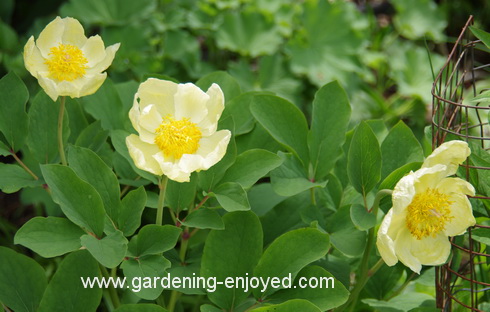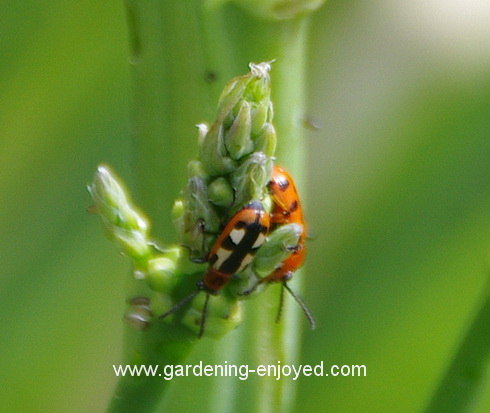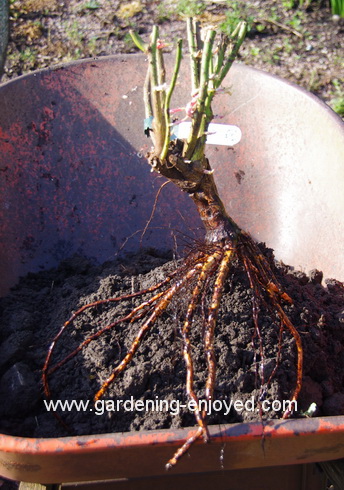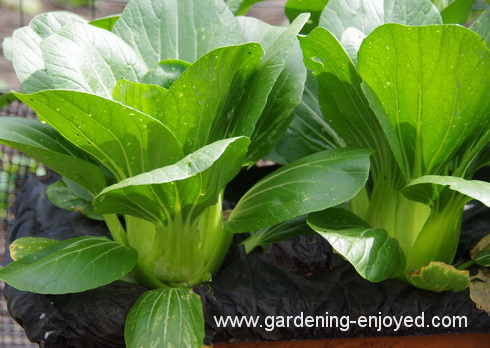
This is my latest prized possession. I planted a root of Paeonia Mlokosewitschii, in the autumn of 2018 and she produced one bloom in 2019 and here she is this year with three of those lovely yellow blooms and out before any other Peony. If you are having trouble with her name, so do most of us, and that’s why she is colloquially known as “Molly The Witch” She is native to the Caucasus mountains of Georgia where she is usually an understory plant and as such she will tolerate light shade. Mine is just outside of the dripline of the Camperdown Elm and gets about a half day of sunlight. She is supposed to be somewhat difficult to grow but she seems quite happy under my care or lack thereof. She fights her way up through the masses of Tulips in that garden and flowers now, just as they are all fading. If you would like a piece of her root, call
me in about 7 or 8 years when she might be big enough to consider dividing.

We move from a very welcome visitor to our garden to one who is certainly less than welcome. Asparagus Beetles have arrived in noticeable numbers already. It must be the heat. Two weeks ago I published the cold weather edition of Dallying and yesterday we broke the heat record for that day. Somewhere above 31C in my part of the world. There are two species of Asparagus beetles, the common beetle and the spotted one. The common is mostly black with some white spots on its wings and the spotted variety is bright orange with black spots. They overwinter as adults and arrive ready to feed and lay eggs. They will both eat the young spears that we would like to eat but their larva are strangely different. The Common beetle larva will eat the developing fronds and can strip a plant in a short period of time. The spotted larva invade the little berries and eat the inside of them. For home gardeners mechanical control, shake the adults off into a bucket of soapy water, is
the best technique. I was watching them today, in an attempt to video them and the two different species actually seem to have a small battle over real estate.
 Back in December of 2019 in Issue #354 of Dallying I showed you Mill On The Floss one of David Austin Rose’s new introductions. On Sunday afternoon Canada Post arrived, yes that’s Sunday sfternoon, with a box from David Austin and inside was my Mill On The Floss bareroot rose to trial in my garden. I had been expecting it for some time but still had been unable to decide where to plant it. Now I had to make a decision. It spent Sunday night in a bucket of water rehydrating its roots and then first thing on Monday morning I had to make that decision. I think it has a great spot in the round bed at the bottom of the garden where there was a significant space between a couple of Iris and Daylilies. David Austin’s roses are never the cheapest in town but look at the quality of that
plant. Several large branches on a well developed root system that would be tough to fit into the usual container that we might buy a Rose in. The downside of getting that healthy a plant is the size of the hole that I have to dig to accommodate those roots and to be deep enough to get the bud union a few cm under the soil. I practically filled a wheelbarrow digging that hole and then, of course, I added a good quantity of my compost to that soil before I backfilled the hole. It’s supposed to grow 140 cm tall so I gave it lots of room and now I just have to wait, water and fertilize in order to enjoy the pink blooms.
Back in December of 2019 in Issue #354 of Dallying I showed you Mill On The Floss one of David Austin Rose’s new introductions. On Sunday afternoon Canada Post arrived, yes that’s Sunday sfternoon, with a box from David Austin and inside was my Mill On The Floss bareroot rose to trial in my garden. I had been expecting it for some time but still had been unable to decide where to plant it. Now I had to make a decision. It spent Sunday night in a bucket of water rehydrating its roots and then first thing on Monday morning I had to make that decision. I think it has a great spot in the round bed at the bottom of the garden where there was a significant space between a couple of Iris and Daylilies. David Austin’s roses are never the cheapest in town but look at the quality of that
plant. Several large branches on a well developed root system that would be tough to fit into the usual container that we might buy a Rose in. The downside of getting that healthy a plant is the size of the hole that I have to dig to accommodate those roots and to be deep enough to get the bud union a few cm under the soil. I practically filled a wheelbarrow digging that hole and then, of course, I added a good quantity of my compost to that soil before I backfilled the hole. It’s supposed to grow 140 cm tall so I gave it lots of room and now I just have to wait, water and fertilize in order to enjoy the pink blooms.

Here I am back in my office after dinner. I want to finish “Dallying” and my office is one of the two rooms with AC. This beautiful green Pak Choi was harvested to become part of that dinner along with a generous portion of fresh Asparagus. The Pak Choi was cut in half longitudinally and then the cut surface was covered with Black Bean Sauce and then it spent about 10 minutes on the BBQ, cut side up for the first half and then over for the other half. I like Pak Choi but possibly too much. I have three of my Earthbox containers filled with different varieties and the purple leafed variety is doing well in the garden. It’s really not too much except that it will all be ready about the same time. We can easily consume those 20 heads of Pak Choi but probably not all in one week. Luckily some of the varieties take longer than others.
This green variety is growing at an amazing pace and it will probably be part of dinner for the next few days. There are 6 plants in that container. My only hope is that we can use all of that Pak Choi in time to replant that container with Peppers or Zucchini. That’s the plan.

This is the quiet garden, just a narrow strip along the fence with the neighbours. Yes, it is a stereotypical “white picket fence.” The Assistant Gardener’s summer task is to repaint that fence and she is almost half way there, but of course not the half in the picture. It’s quiet because nothing flashy happens here until October. Those huge clumps of dark green foliage are the spring growth of the autumn flowering Colchicum. Judging from the amazing growth we are seeing this spring, the October display of large pink blooms should be amazing. Those leaves will start to die down in the next few weeks and in between them is a delicate perennial grass, Heavy Metal. Heavy Metal Blue Switch Grass (Panicum virgatum ‘Heavy Metal') is a choice ornamental native grass named for its attractive, stiffly upright blue-gray foliage. It blooms with attractive tan flowering sprays in late summer. These clumps should
completely hide the gaps where the Colchicum leaves have departed. The whole narrow bed thus stays as a quiet bed with varying shades of green until it bursts forth in October. Sometimes a plan actually works!
To ask a question just “reply” to this ezine. Don’t forget to check the front page of the Website for frequent short ideas for current gardening activities.
Christine Asks?Help! Some critter has eaten most of my tulips. They chomp off the flowers and leave them on the ground. I put down some dog hair with no results - other than our poor dog having a very bad haircut. Then I scattered cayenne pepper on the tulips. That didn't help. Have you any other suggestions? .
Ken Answers!I have seen that happen and I have accused the squirrels but have never actually seen them do it. I also have rabbits in my garden but I don't think they are guilty. I
have no solution for you but if you have that dog then keep her in the yard to chase the squirrels. Most repellents work on bunnies and deer but not on squirrels for some reason. You can try trapping and relocating but when I do that the numbers don't seem to decrease.
L? Asks? Thanks for doing this ezine. I look forward to it showing up in my inbox. This is the 2nd spring for these tulips and some clumps are blooming and some are just a mess of floppy leaves. I'm at the point in life that if plants don't behave out they go. Is there any hope for the non blooming tulips?
Ken Answers! They might eventually make a big enough bulb to flower but I just eliminate them and plant new ones in the fall.
Brenda Asks? Have a question for you regarding a small white worm with a black head attacking my hydrangeas. They make a cacoon out of the leaves and then proceed to eat the leaves. Anything I can do other than manually squishing
them? I talked to a woman working at Grobe's garden centre and she said she just cuts the cocoon off and throws it in soapy water. What do you think!
Ken Answers! Hydrangea leaf roller is nasty and I know of no control except hand
opening each cocoon and squishing the bug. Cutting the cocoon off will sort of solve the problem but you will also be cutting off the growing point and that will probably make it start growing from some of the lower leaves.
|

 Back in December of 2019 in Issue #354 of Dallying I showed you Mill On The Floss one of David Austin Rose’s new introductions. On Sunday afternoon Canada Post arrived, yes that’s Sunday sfternoon, with a box from David Austin and inside was my Mill On The Floss bareroot rose to trial in my garden. I had been expecting it for some time but still had been unable to decide where to plant it. Now I had to make a decision. It spent Sunday night in a bucket of water rehydrating its roots and then first thing on Monday morning I had to make that decision. I think it has a great spot in the round bed at the bottom of the garden where there was a significant space between a couple of Iris and Daylilies. David Austin’s roses are never the cheapest in town but look at the quality of that
plant. Several large branches on a well developed root system that would be tough to fit into the usual container that we might buy a Rose in. The downside of getting that healthy a plant is the size of the hole that I have to dig to accommodate those roots and to be deep enough to get the bud union a few cm under the soil. I practically filled a wheelbarrow digging that hole and then, of course, I added a good quantity of my compost to that soil before I backfilled the hole. It’s supposed to grow 140 cm tall so I gave it lots of room and now I just have to wait, water and fertilize in order to enjoy the pink blooms.
Back in December of 2019 in Issue #354 of Dallying I showed you Mill On The Floss one of David Austin Rose’s new introductions. On Sunday afternoon Canada Post arrived, yes that’s Sunday sfternoon, with a box from David Austin and inside was my Mill On The Floss bareroot rose to trial in my garden. I had been expecting it for some time but still had been unable to decide where to plant it. Now I had to make a decision. It spent Sunday night in a bucket of water rehydrating its roots and then first thing on Monday morning I had to make that decision. I think it has a great spot in the round bed at the bottom of the garden where there was a significant space between a couple of Iris and Daylilies. David Austin’s roses are never the cheapest in town but look at the quality of that
plant. Several large branches on a well developed root system that would be tough to fit into the usual container that we might buy a Rose in. The downside of getting that healthy a plant is the size of the hole that I have to dig to accommodate those roots and to be deep enough to get the bud union a few cm under the soil. I practically filled a wheelbarrow digging that hole and then, of course, I added a good quantity of my compost to that soil before I backfilled the hole. It’s supposed to grow 140 cm tall so I gave it lots of room and now I just have to wait, water and fertilize in order to enjoy the pink blooms.


